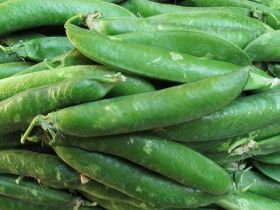Peas
The simple pea is a staple of the modern diet and fortunately for us it is relatively easy to grow in a temperate climate. It is an annual plant that grows best at temperatures between 13 and 18 degrees Celsius. It typically takes around 12-16 weeks between sowing and harvest. Pea plants can self-pollinate. Varieties of peas are numerous and include mange tout and sugar snap peas, which are types of garden pea that can be eaten at an earlier stage of maturity. Due to their short growing time, these are the easiest ones to grow.
Growing Peas:
Peas can be sown in a cold-frame or polytunnel in autumn or directly into the soil once it warms up in the spring, usually between March and June. Sow seeds every two weeks to get fresh peas over a longer period.
Peas like a warm, nutrient rich, moisture-retentive soil and are usually planted in rows or shallow trenches around 5cm deep. They can be supported by pea-sticks or bamboo canes and netting. Shorter varieties planted in wide rows will not need as much, if any, support as they will hold onto each other. Shelling peas come in either wrinkled or round seed varieties. Choose the former for early sowing as they are hardier, while the latter are sweeter and better for summer sowing. Earlier sowings should be protected by cloches if frosts are expected. Rather than buying cloches, why not use old plastic drinks bottles to protect early peas?
Water well over the warm summer months. It is a good idea to water well and then lay a thick mulch down to prevent too much moisture loss from the soil. One option is to mulch using grass clippings, which are readily accessible to many of us.
Watch out for mice and pigeons who will try to eat pea shoots and peas before you can. If you are being taxed too heavily by these greedy creatures, growing elsewhere and transplanting, and netting against birds, are the only ways to reduce damage. Plant early or late to avoid pea moth.
If you play your cards right and choose the right varieties you could be picking fresh peas between June and October. Make sure to pick pods as soon as they are ready. For shelling varieties, you can see if the peas have reached the right size when you hold the pod up to the light. Pick from the bottom of the plant and keep picking or the plant will stop producing new pods.
Why grow peas in the garden?
Peas are not only good to eat – so much better fresh from the garden than they are from the shops – they are also a help to other plants in the garden. Like all plants in the legume family, peas (or rather peas working with the beneficial nitrogen fixing bacteria living in their roots) take nitrogen from the air and feed it back into your soil, where it can be taken up by other plants. When peas are done, leave roots in place, then follow with a plant with high nitrogen needs.
Legumes planted throughout your garden will prevent the need for non-organic and expensive fertilisers. The whole family will have fun harvesting and eating the crop.
